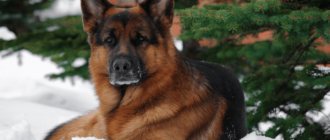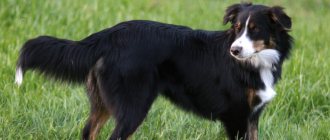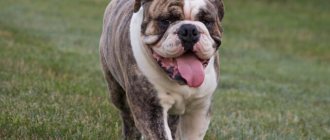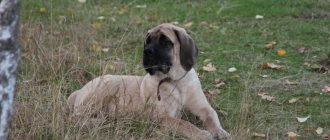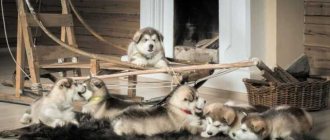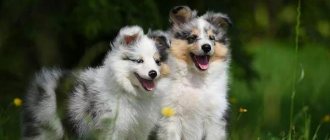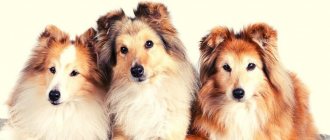The German Shepherd is one of the popular breeds in the world. Every child dreamed of such a dog, because one of the main qualities is their loyalty and intelligence.
This smart dog will easily become the guard of your peace, a faithful comrade, and a brave fighter. It appeals to military personnel, police officers, children, and dog lovers.
Features and description
When we hear “ German Shepherd breed ” the first thing that comes to mind is loyalty, endurance and courage. Such associations exactly correspond to objective reality. Representatives of the breed have gone through a long development stage. It is said that their descendants were timber wolves.
A person actively involved in the issue of breeding efficient and beautiful dogs in the 19th century was Max Emil. Before the modern representative of the breed was born, this breeder crossed many popular shepherd dogs with each other.
The result of such experiments was a dog with good working abilities, but an unpresentable appearance. The selection continued. Only at the end of the century did the world become acquainted with a loyal, strong and very cute dog.
Interesting fact! Almost immediately after being bred, the German Shepherd became the national symbol of Germany.
The representative of the breed is universal in nature. It can be used by a person as a security guard, bodyguard, rescuer, guide, cattle breeder and simply a faithful comrade. He copes well with each of these types of “work”.
He is distinguished by responsibility and love for people. If you are used to a person, you will never betray him or leave him in trouble. He might give his life defending him. He will not be afraid even of weapons. This dog is observant and careful. She will never attack a person without a reason, but if he seems dangerous to her, she attacks. She is very smart and capable of making independent decisions.
The main feature of the animal is the presence of a deep sense of justice. Despite its warlike appearance, it is very vulnerable and affectionate. Strives to honestly serve a person, but in return requires a lot of attention and care. Being ignored greatly upsets him.
This set of service and psychological qualities of the dog served as the reason for its exploitation at customs. She has an excellent sense of smell, good observation and responsibility. All this helps to quickly identify a criminal, perhaps even a drug dealer.
Nature has not deprived the dog of artistic talent. The German Shepherd regularly takes part in filming advertisements for dry food, collars, veterinary hospitals, etc. Moreover, she is also invited to appear in TV series and films. In cartoons, it symbolizes courage and bravery. Children love this dog because it is friendly with them. She always inspires confidence and is capable of affection. Very contactable.
German Spitz
- Height – up to 40 cm
- Weight – up to 15 kg
The dog is a companion, from which many other decorative pets originated. The coat is thick and fluffy, the color is white, gray, there is an undercoat. The German Spitz is distinguished by good health, peaceful character, activity, intelligence and loyalty.
Pros:
- sharp mind and quick wit;
- love for children.
Minuses:
- prone to obesity;
- require training.
Breed standard
The German Shepherd dog is medium in size and weight. Her body is elongated, and her bones are rather dry. Height at withers - from 59 to 65 cm, weight - from 32 to 38 kg. The weight of some large males reaches 40-42 kg, this is not considered a deviation.
Gives the impression of a strong beast. The muscle corset is very developed. In purebred German Shepherds, the lower part of the body should be inclined towards the ground. This is a feature of their exterior. The fact is that the dog’s hind legs are quite long, and the front legs are much shorter. Therefore, it seems that he is practically dragging them along the ground. The dog's hip muscles are very strong. In the same zone there are strong bone cartilages.
The tips of the paws have hard black pads. The claws are medium in length and dark. Over time, they wear down, especially if the animal moves a lot. The chest is well defined, the abdomen is sunken. The tail is long, reaching to the ground. When the dog is calm, it hangs down, and when excited, it rises to the level of the waist.
The shepherd has a rather large head, the shape of the skull is round. The forehead is well defined. The distance between the ears is not wide. The eyes are round, with light brown irises. There are long thick black eyelashes. The nose is large and dark.
Important! Pedigree German Shepherds should have 5 moles on their face: 4 on the cheeks and one on the neck (throat area).
The coat of such dogs can be long, short or medium in length. But it must be direct. There is a thick undercoat. The fur on the muzzle, paws and belly is short, but on the sternum, back and withers it is the longest. There are many colors:
- Black-and-white.
- Zonal.
- Pure black.
- Pure white.
- Reddish-gray.
- Grey-white.
Of course, the German Shepherd in the photo in most cases is depicted as black-haired. This color of her coat is the most common. It is extremely rare to find a purely white or black representative of the breed. The black-backed dog's back is black, as is the top of its tail and the tip of its muzzle. There are also dark marks on the dog's cheeks. There is delicate white fur on the lower thigh. By the way, shepherd puppies are born dark, becoming lighter around 4 months.
German Jagdterrier
- Height – about 40 cm
- Weight – up to 25 kg
A hunting breed of dog, bred in Germany for hunting, guarding and helping people. At the same time, the dog is easy to care for and easily takes root in any conditions. The dog has a medium body, powerful paws and chest. The coat is hard with undercoat, the color is dark, red. By nature, the German Jagdterrier is distinguished by stubbornness, independence, hot temperament and endurance.
Pros:
- loyal and quick to learn.
Minuses:
- are aggressive;
- require constant discipline.
Character
Those who were the owner of a German shepherd rarely get dogs of other breeds. There is an explanation for this. The fact is that a representative of this breed is not only efficient, but also very smart. His intellectual abilities are amazing.
This dog always understands what mood its owner is in, and he can also adapt to it. It is well trained, but is willful. Every smart dog needs proper and consistent training.
If you don’t teach her the rules of behavior from childhood, she will become angry and difficult to control. The German Shepherd is very self-confident, knows that it is smart and strong, so it often becomes self-centered. Quite proud, prone to independence. But, despite all these shortcomings, she is affectionate and responsible.
The love of this breed for its owners is limitless. He is filled with joy when he looks at them. When household members pet or kiss the dog, he rejoices. She never skimps on her feelings and strives to demonstrate her love and tenderness to her loved ones. In everyday life he is very affectionate. Can sit next to people for hours. Doesn't like loneliness or isolation. Prefers to be the center of attention.
Naturally strong and resilient. He is prone to competition, because he knows his own worth and can challenge any opponent. He is ready to fight for the attention and love of his owner by any means. If he gets another dog, the shepherd will bully it, maybe even bite it. It is important to pay attention to this in time and correct her behavior.
It is a mistake to think that a representative of this breed is exclusively a “working” pet. Yes, he will faithfully guard his household and the territory in which they all live, but this does not prevent him from showing tenderness and affection. It's cute to watch a large guard dog roll over on its back in front of a person, inviting him to pet him.
Note! When a dog bares its belly, it shows its trust in you. This part of her body is the most vulnerable, therefore, showing it, she says: “Man, I’m not afraid, but I love you, you can stroke me.”
Thanks to its full range of positive character traits, the German Shepherd is an ideal family dog. She serves her family faithfully, looks after the children responsibly, and loves to play and have fun. But you should not expect that such a dog will be friendly with every person, especially with strangers.
Do not forget that, first of all, this is a guard dog that protects and protects the members of its pack. There is no point in teaching her how to guard, since she herself knows and feels how to do it.
This is why the German Shepherd will express aggression towards every person standing outside its territory. But as soon as the owner appears and greets the guest, the dog’s attitude towards him will immediately change.
He will understand that since the owner is friendly with the stranger, then he does not pose a threat. She always relies on him, but sometimes she becomes obstinate and decides on her own. By nature he is merciful. Protects those who are weaker than him. Never gets involved in conflict without reason. Seeks the owner's approval. Loves sports and active recreation.
Origin of the dog breed German Shepherd
Researchers are convinced that the origins of German Shepherds should be sought in the mists of time. Their evidence suggests that they most likely descended from timber wolves that decided to live closer to the tribes of ancient people.
In the course of evolution, they became similar to herding dogs that protected farm plots from external enemies. By the beginning of the 18th century, there were already two types of such herding dogs, differing in their character and appearance, so the breeders decided to unite to create a new breed.
A great contribution to the breeding of German Shepherds was made by Max von Stephanitz and Arthur Meyer, as well as their followers, who continued the development of the breed even after the death of von Stephanitz, who was breeding German Shepherds from 1884 to 1896.
Their activities were based on maintaining the purity of blood, which had to be proven by documents, and they also sought to develop as much as possible in the breed qualities that would be useful in helping humans.
Care and maintenance
The German Shepherd is in great need of exercise. She is strong, but can weaken if she is not trained regularly. The dog loves to run cross-country or sprint. Can live both in a house and in an apartment. But keep in mind that you need to walk with her outside the house a lot and often.
It is much easier for those who live in a private house. A dog who prefers active recreation can live comfortably on the street. It's better for him to sleep in a booth. In winter it can be insulated with hay or cotton wool. There is no need to worry that your pet will catch a cold. It has a very dense undercoat that warms well. By the way, in the summer he actively sheds.
We do not recommend putting the “German” on a chain. This is a very smart and strong dog that needs to be given freedom of movement. We also do not recommend locking her in an enclosure for a long time. Of course, it is better for the animal to sit there if there are a lot of people in the yard. Get him accustomed to the enclosure in the first days of your acquaintance.
The dog's fur is very dense and can get tangled, so it needs regular brushing. You can purchase a separate comb for it. It must be cleaned periodically with alcohol for disinfection purposes. If your pet has too long fur on his thighs, it is better to cut it off in the summer. Without this, it will become tangled and dirty.
Bathing such a dog too often is highly discouraged. It is advisable to do this as it gets dirty, but not more than 2 times a year. The best time of year for swimming is summer. The dog should be soaped, rubbed and rinsed with clean water. She will shake off the excess water herself and begin to move, which will allow her to dry faster.
If you are forced to carry out this procedure in an apartment, you will have to wipe it with a towel. If your dog's nails grow too quickly, they will have to be trimmed. Otherwise, he will start to hurt himself when he washes himself or scratches himself.
You also need to take care of the animal's teeth. Plaque will form on their surface; it can simply be removed with a human toothbrush. Large ears are wiped with cotton wool from the inside to remove wax. Well, the last moment is washing. If you notice souring in your dog’s eyes, wipe his face with a damp cloth and rinse with water.
German Shorthaired Pointer
- Height – about 60 cm
- Weight – 30-40 kg
A pointing breed with short hair. The body is athletic and slender, the color is dark, sometimes with a milky tint and inclusions. The dog can be used for guarding and hunting small animals. The German shorthaired pointer is characterized by loyalty, confidence, endurance and poise.
Pros:
- learn quickly;
- The coat requires almost no maintenance.
Minuses:
- It’s hard to get along in an apartment.
It might be interesting: Nicknames for dogs for boys, 1000 options.
Nutrition
A German Shepherd puppy needs a complete, balanced diet. If fed incorrectly, he will grow up weak, sad and distant, and his coat will not have shine. It is important that the baby receives amino acids and proteins every day. These nutrients are found in milk, cereals and meat.
A complete list of foods that should be fed daily to a puppy from 2 to 8 months:
- Buckwheat or wheat porridge.
- Chicken (preferably raw).
- Milk or semolina.
- Cucumbers, broccoli, lettuce, tomatoes.
- Bananas, strawberries, apples, melon.
Never feed your pet raw sea fish, as it contains bones and possibly parasites. It is also recommended to permanently eliminate pork, smoked lard, sharp bones (especially beef), chocolate, biscuits and marmalade from his menu. Eating such foods can cause digestive dysfunction in dogs. Dry food can be given to an adult “German” over 1 year old.
Diet
Dogs of this breed expend a huge amount of energy due to their activity and size. Therefore, their daily diet should contain a sufficient amount of proteins, fats, complex carbohydrates and vitamins.
The main part of the diet should be meat products, for example, with vegetables. You should not overuse cereals - they are poorly digestible. Also be careful with dry foods that may cause allergies in your dog.
Remember a few simple rules:
- The main part of the diet is meat;
- Don't overfeed your dog;
- Don't feed your dog table scraps;
- Do not give your dog anything too sweet, salty or fried, as well as foods with a lot of small bones and fresh bread.
Reproduction and lifespan
A reliable guard, a loyal friend and just a beautiful pet - all this describes the German Shepherd perfectly. She lives from 12 to 14 years, but only with good care. Breeders planning to breed these types of dogs should be well aware of their standard. It is also advisable to breed individuals of the same color. Only in this case can one raise offspring that are correct in every sense.
A male dog can be the same age as a female dog, the main thing is that each of them is over 1.5 years old. It is not advisable to have dogs over 7 years old. Each of the potential parents must be psychologically stable and of high breed.
They are mated in the male's territory. This happens when the bitch is in heat. If she becomes pregnant, then by 8-10 days after reproduction her tummy will be noticeably rounded. You can expect puppies in 70 days (plus or minus 3 days).
German dog
- Height – 75-90 cm
- Weight – up to 90 kg
It has a large size, color - fawn, marble, gray, black and blue. The coat is short and smooth. You can use a Great Dane as a guard, watchman or companion. The character is characterized by loyalty, playfulness, devotion, peacefulness and friendliness.
Pros:
- easy to learn;
- lives long.
Minuses:
- better kept outside the city;
- Because of its weight, a dog can easily overwhelm an adult, even when playing with him.
Price
If you dream of becoming the owner of one of the most popular dogs in the world, we recommend going to a kennel for her. No, you don’t have to go to Germany; there are high-bred “Germans” in almost every country in the world, including Russia. The price of a German Shepherd from a kennel is from 15 to 25 thousand rubles. It depends on the age of the puppy, as well as on its compliance with the standard.
The cost from private breeders is lower (from 6 to 12 thousand rubles). If you do not need full compliance with the dog’s breed standard and its pedigree, we recommend saving money and using their services. However, before purchasing, be sure to inquire about the vaccinations that the puppy received.
Possible diseases
German Shepherds are resistant to many diseases, with the exception of the eyes and musculoskeletal system.
Remember the following essentials:
- Timely examination by a veterinarian;
- Vaccinations (keep a vaccination calendar);
- Prevention against internal and external parasites;
- Washing and grooming.
Education and training
Let's start with the main thing: if you want to raise a “German” who is successful in work and social terms, then get ready for the fact that it will take a long time to train him, especially in the first year of his life. It is believed that a working dog is more successful if it is raised by 1 person. By the way, it is he who is perceived by her as the owner.
It is necessary to build a hierarchical and trusting relationship with her. She must understand that she is in a subordinate position. You cannot gain the authority of a service dog by force. You need to prove your superiority to her humanely. Teach her the rules of behavior in the house, be consistent, do not spoil her and do not allow her to misbehave with impunity.
When you bring your Shepherd puppy into your home, it is a good idea to let him explore the area. It is important that he sniffs every corner. This is how he adapts to new conditions of detention. Control this process. Don’t let your baby get scared of something; in this case, protect him. For example, you can pick up your puppy or lean down to pet him.
Teach commands early, within a week of home socialization. The representative of the breed is definitely not deprived of intelligence, so he learns new things quickly and effectively. When training classic teams, don't forget to treat him with something tasty as a reward. Don't let him get overtired. If the dog gets tired every time, he will develop a negative attitude towards training.
The next important point is leash walking training. Remember, a leash is a connection between you and your pet. He must learn to walk next to his owner and not be distracted. To do this, put a collar on your pet, attach a leash and practice walking together near your home. Avoid meeting other dogs.
Important rule! Never take your German Shepherd outside until he is at rest. You can sit with her near the front door for a few minutes, waiting for her level of arousal to subside.
It is also impossible to allow the development of so-called food aggression in a shepherd dog. This phenomenon involves the dog showing anger while eating food. Some service dogs try to protect their food from theft in this way.
But a representative of the breed should be trusted by members of the household. A simple way to prevent food aggression is to pet a young dog while it eats. This way she will get used to the fact that there are kind people nearby who do not pose a threat and will begin to calmly eat in their presence.
Dog training German Shepherd
In the first months of a puppy’s life, with the help of simple games and tasks, you need to teach simple rules of behavior and do not forget to give them a reward in the form of treats.
From the very beginning, the owner must demonstrate his authority, but this must be done carefully, without using brute force. If you can’t do this on your own and the puppy’s behavior deviates from the norm, you can contact a dog handler.
It is important to teach the puppy at least basic commands, and when he grows up, he should be taught to walk with a leash and muzzle and, of course, be rewarded for this with a tasty treat.
However, you need to be careful about stress, as even the best German Shepherds are susceptible to nervous breakdowns due to overtraining.
Possible diseases and methods of treating them
You cannot call a German Shepherd a weak and sickly dog, but there are factors that will certainly undermine its health. The main one is unhealthy diet. If your pet sleeps a lot, defecates frequently and refuses to eat, this is a warning sign. His digestion was probably disrupted.
A sick dog should be taken to an animal clinic and seen by a specialist. In most cases, digestive dysfunction in dogs is treated by taking sorbents. The veterinarian will prescribe the medicine and determine the dosage. You can give sorbents to your pet yourself at home.
Almost all German Shepherds have a genetic defect - weak, inelastic leg joints. When the dog is not injured, the pathology does not manifest itself in any way, but if it falls, for example, on ice, it will easily damage a limb. Painkillers will help the animal.
The German Shepherd is not only a fearless bodyguard, but also a loyal and affectionate friend. She will always come to the aid of people who love her and will never leave them of her own free will.
How to choose?
When choosing a German Shepherd, cynologists recommend adhering to several rules.:
- choose a place to take the puppy. It is not worth buying on the market; most often the sellers do not have documents, or they are fake. It is better to take puppies from kennels where dogs are bred according to mating rules;
- look at all the dogs in the litter, not just one. If they are all active and healthy, eat properly and are not afraid of people, then you can adopt a puppy;
- take a closer look at the animal, take it in your hands. It would be a good idea to pay attention to the weight; for a one-month-old puppy it should be from two to four kilograms;
- don't be afraid to ask questions. It is worth finding out the pedigree of the animal and viewing supporting documents.
Every German Shepherd has good potential, for the development of which you need to systematically work with your pet..
Proper upbringing will make him a loyal friend and helper for the whole family. However, remember that before purchasing you should weigh all the pros and cons, because any animal is not only a joy, but also a great responsibility.
Miniature Schnauzer
- Height – up to 35 cm
- Weight – up to 8 kg
The Miniature Schnauzer is considered the smallest working dog in the world. Color can be silver, black, white. The coat is short, but thick and soft. By nature, miniature schnauzers are loyal, hardy and fearless pets.
Pros:
- easy to learn;
- love children;
- feel the mood of the owner.
Minuses:
- requires physical activity.
Differences between Shepherds and Mutts
Now, summarizing all of the above, let's make a basic list of features that distinguish a purebred German Shepherd from a mongrel or mestizo:
- Two-month-old German Shepherd babies are much larger than mongrels - they grow and develop much faster. Their skeleton is already beginning to acquire classic harmonious shapes, their paws become powerful and strong. Mongrels at this age are still very small - their maturation occurs much more slowly;
- Mutts usually have a very noticeable furrow on the forehead, which you will not find on purebred Germans;
- Remember about the bite - it must be scissor-shaped, while in mongrels the bite can be anything. This is one of the weak points of non-purebred dogs - their characteristics are unpredictable, being a kind of lottery;
- The shepherd must have no dental defects - any curvature and the presence of extra fangs or incisors is sufficient grounds for rejection;
The shepherd must have no dental defects
- Despite the fact that small shepherd dogs have mug-like ears, as they grow older they become hard and stand on the head. In yard dogs, as a rule, the ears remain hanging - this is why they do not seem as noble as the Germans;
- The mongrel has a barrel chest, while the purebred puppy has a massive and developed broad chest;
- The breed can also be distinguished by the shape of its paws - in Germans they are powerful, hard and developed with strong joints and without curvature.
Pros and cons of herding dogs
Before we dive into the most popular herding dog breeds, let's take a look at some common characteristics shared by most of these dogs.
It is also important to note that every dog, regardless of breed, is an individual. There are a lot of “outliers”, especially if you are considering Métis. However, knowing the pros and cons of livestock dogs will save you from getting into trouble when you adopt a pet that turns out to have more needs than you can meet.
Highly intelligent and easy to train
At first glance, these are extremely positive qualities. Who doesn't want a smart dog that's easy to train? After hundreds of years of selective breeding, most breeds in the herding group have above average intelligence and respond very well to training methods based on positive reinforcement.
These qualities are great for people looking for a dog that quickly learns tricks, excels in competitive dog sports, or helps with livestock. However, smart dogs have a downside: they tend to require special care.
If you don't have the time or knowledge to train your Cattle Dog, his unmet high needs for mental stimulation will turn him into a bored, frustrated and neurotic pet.
Active, mobile and sporty
Most dogs in this group are natural athletes, built for long runs and endurance jobs such as keeping a flock of sheep in line. With a few exceptions, herding dogs have a great need for exercise that cannot be satisfied by short walks in the park.
If you want your Cattle Dog to remain level-headed and calm, several hours of vigorous off-leash play (fetch, Frisbee, jogging, etc.) is required at least two or three times a week. For some breeds, such as border collies, even this will not be enough in most cases.
If you live in an apartment or don't have access to fenced-in outdoor spaces, a herding dog may not be the best choice for you. On the other hand, if you want to take home a few medals from dog competitions like flyball or agility, or have a partner to accompany you on your daily outdoor adventures, then go for it!
Loyal and strongly attached to his family
Because herding dogs are bred to work with people, they can make extremely loyal and affectionate companions. However, some breeds, such as the German Shepherd, tend to be territorial, meaning clear and firm leadership on your part is an important safety requirement.
So if you have the time and are looking for a loyal, active companion with above average intelligence, then the Cattle Dog is for you.
